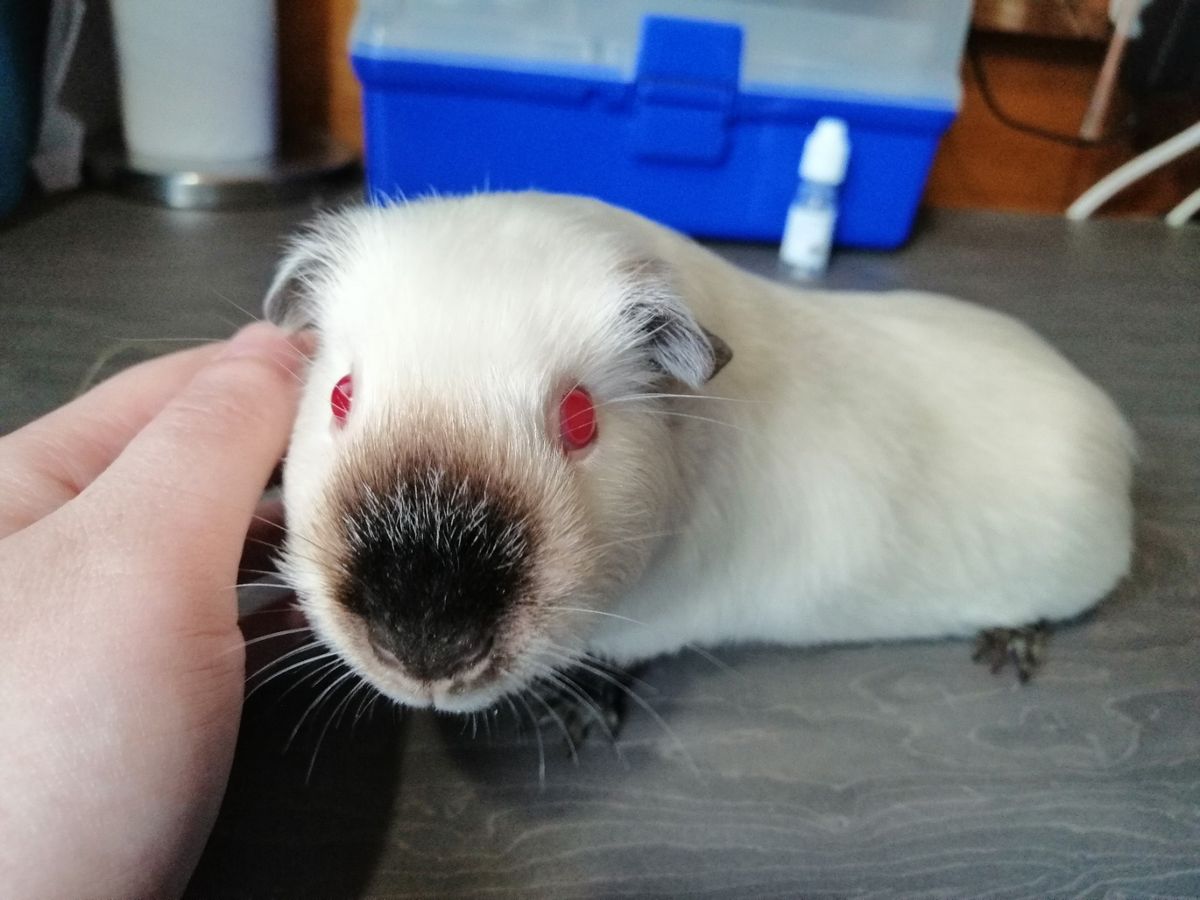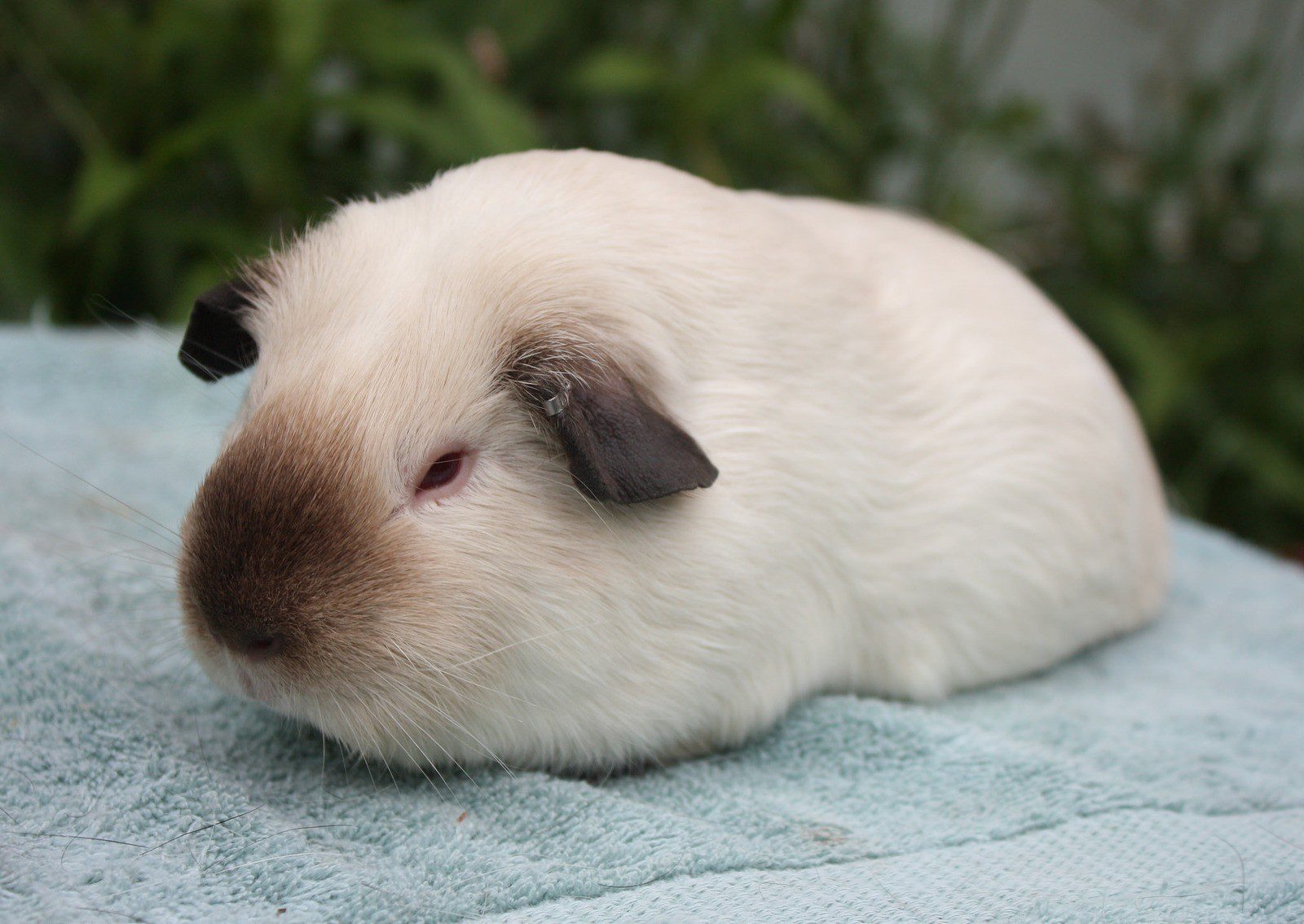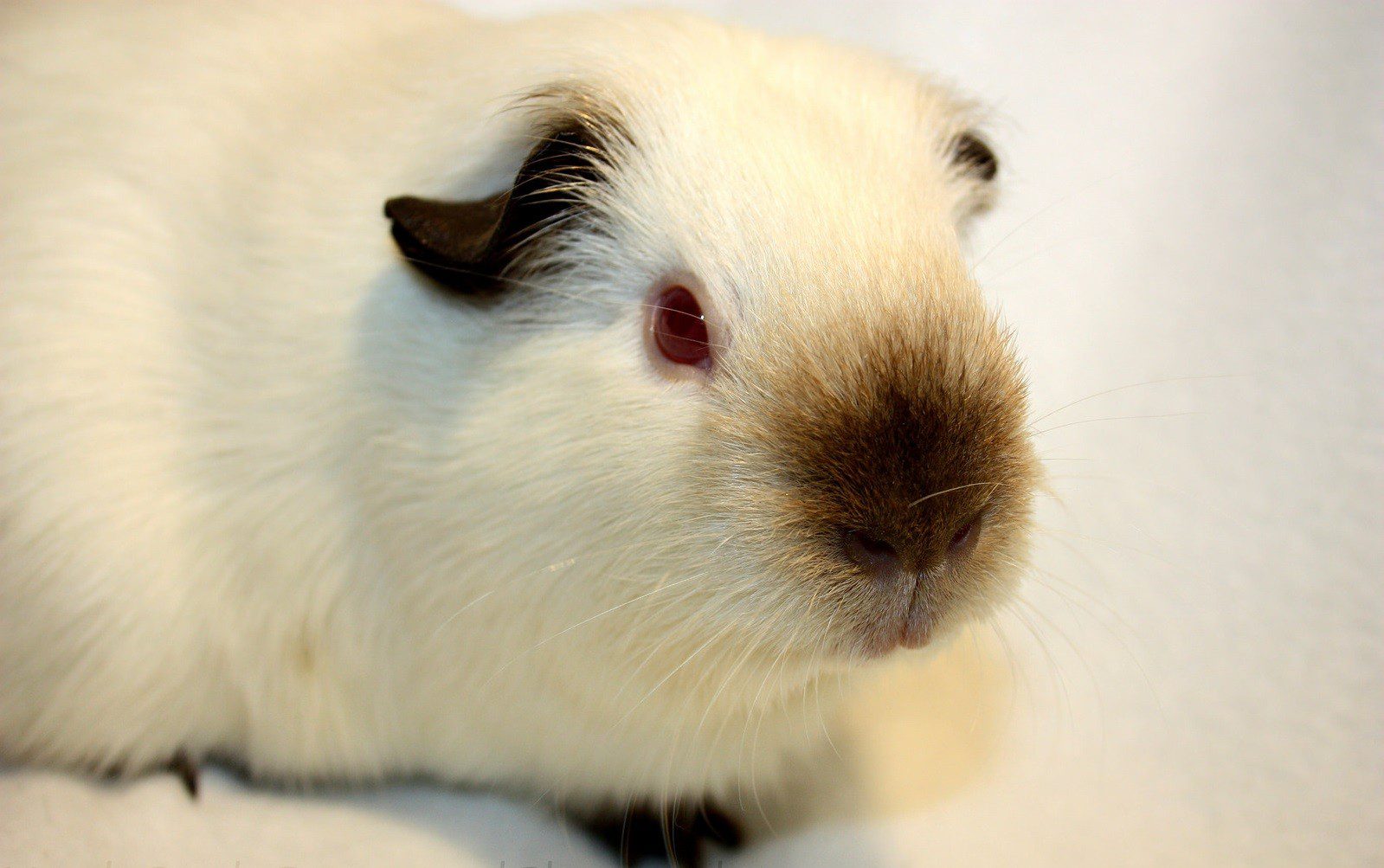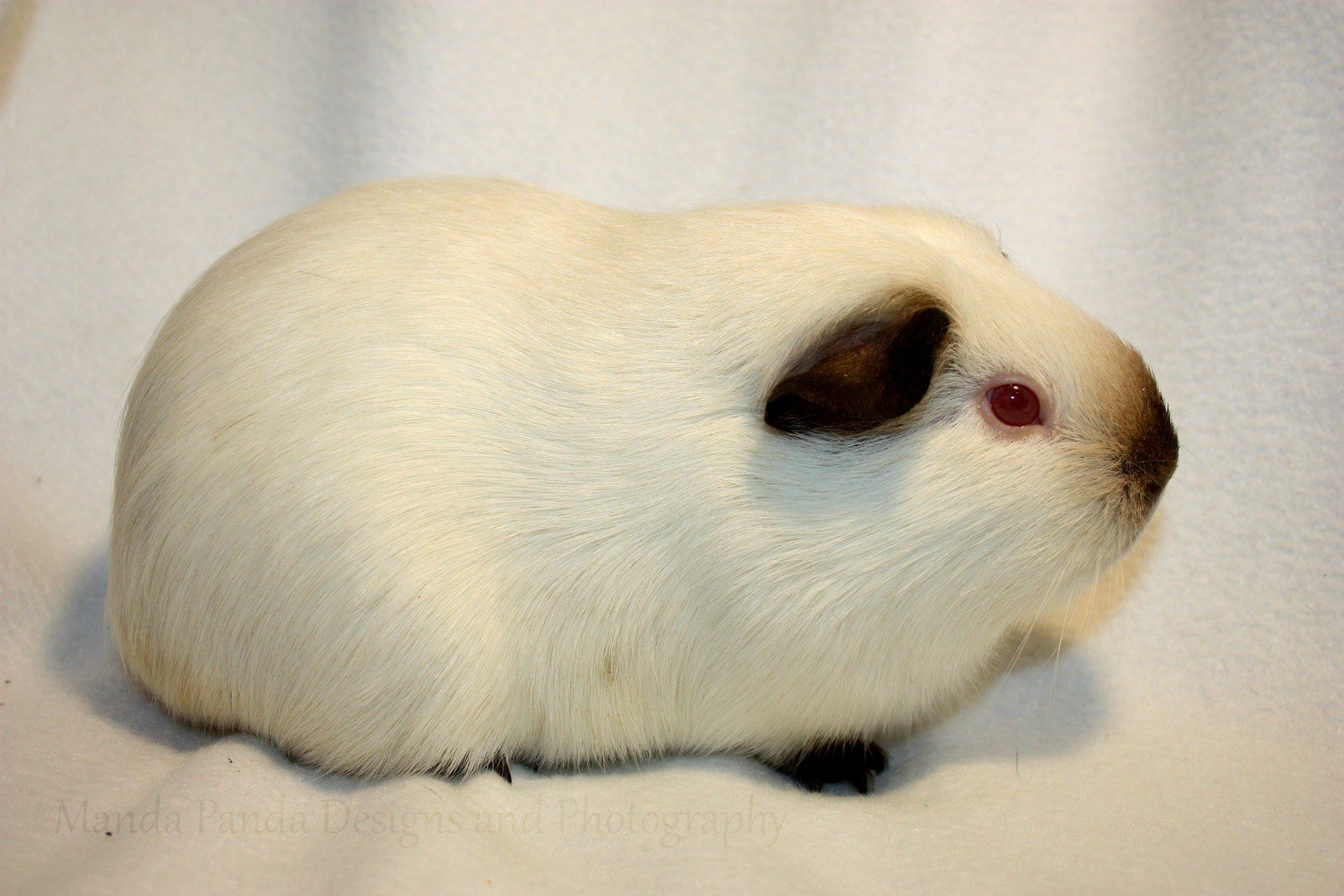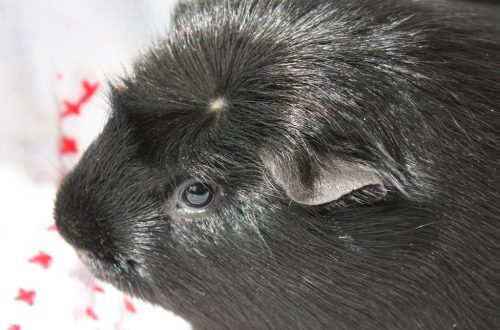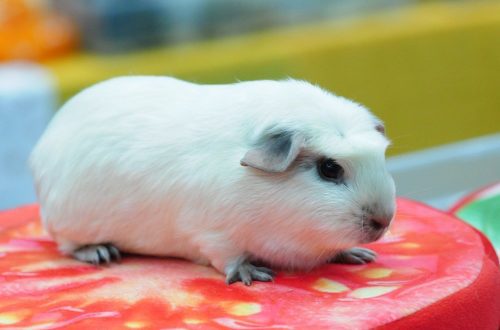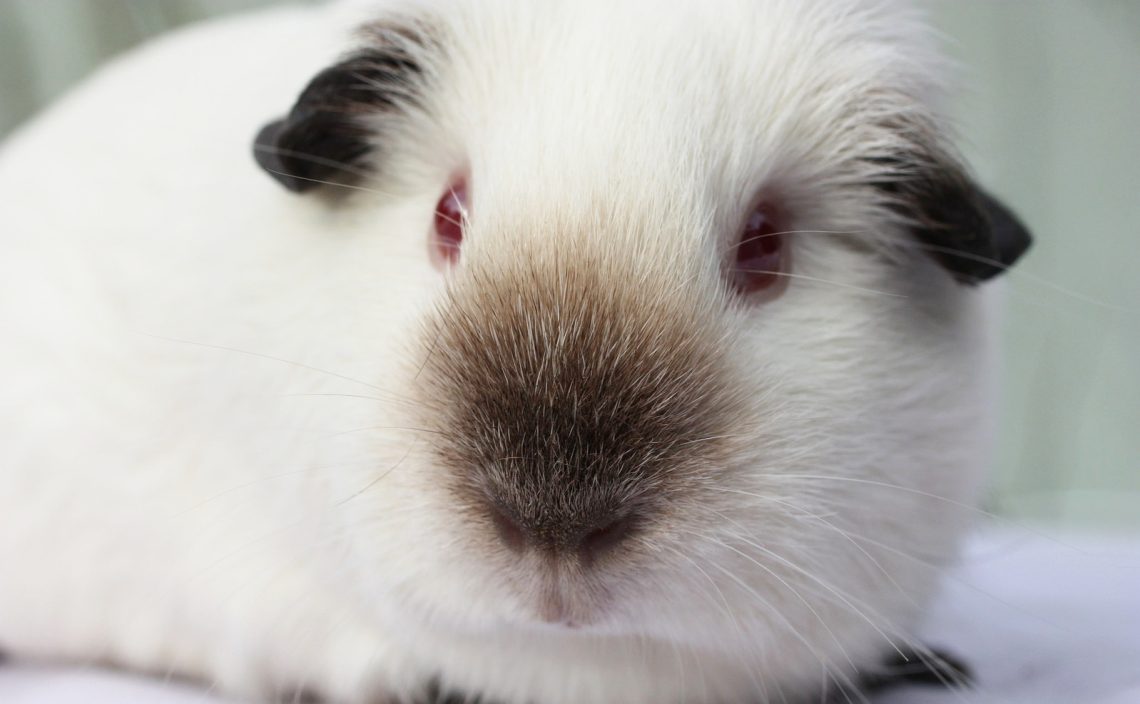
Himalayan guinea pig
Himalayan pigs have not yet received official recognition, but this breed has already found its admirers around the world.
Himalayan pigs have not yet received official recognition, but this breed has already found its admirers around the world.
Contents
Key Features of the Himalayan Guinea Pigs
So what exactly is a Himalayan guinea pig? This is an albino pig with pigmentation of the skin and wool in some areas (mask on the muzzle, paws and ears). The mask, ears and paws can be either black or various shades of brown.
The presence of pigment in any living creature is determined by a chemical substance called melanin. The only creatures that don’t have it are “true albinos”. Himalayan guinea pigs are partial albinos because they can form pigment on certain areas of the body (mask, ears and paws). These are the areas where body heat is lost and the need for insulation from the cold is greatest. It’s like in humans – the maximum amount of heat is lost through the top of the head, hands and heels, and therefore we wear hats, gloves, etc. in the cold to keep our body warm in the cold.
So what exactly is a Himalayan guinea pig? This is an albino pig with pigmentation of the skin and wool in some areas (mask on the muzzle, paws and ears). The mask, ears and paws can be either black or various shades of brown.
The presence of pigment in any living creature is determined by a chemical substance called melanin. The only creatures that don’t have it are “true albinos”. Himalayan guinea pigs are partial albinos because they can form pigment on certain areas of the body (mask, ears and paws). These are the areas where body heat is lost and the need for insulation from the cold is greatest. It’s like in humans – the maximum amount of heat is lost through the top of the head, hands and heels, and therefore we wear hats, gloves, etc. in the cold to keep our body warm in the cold.
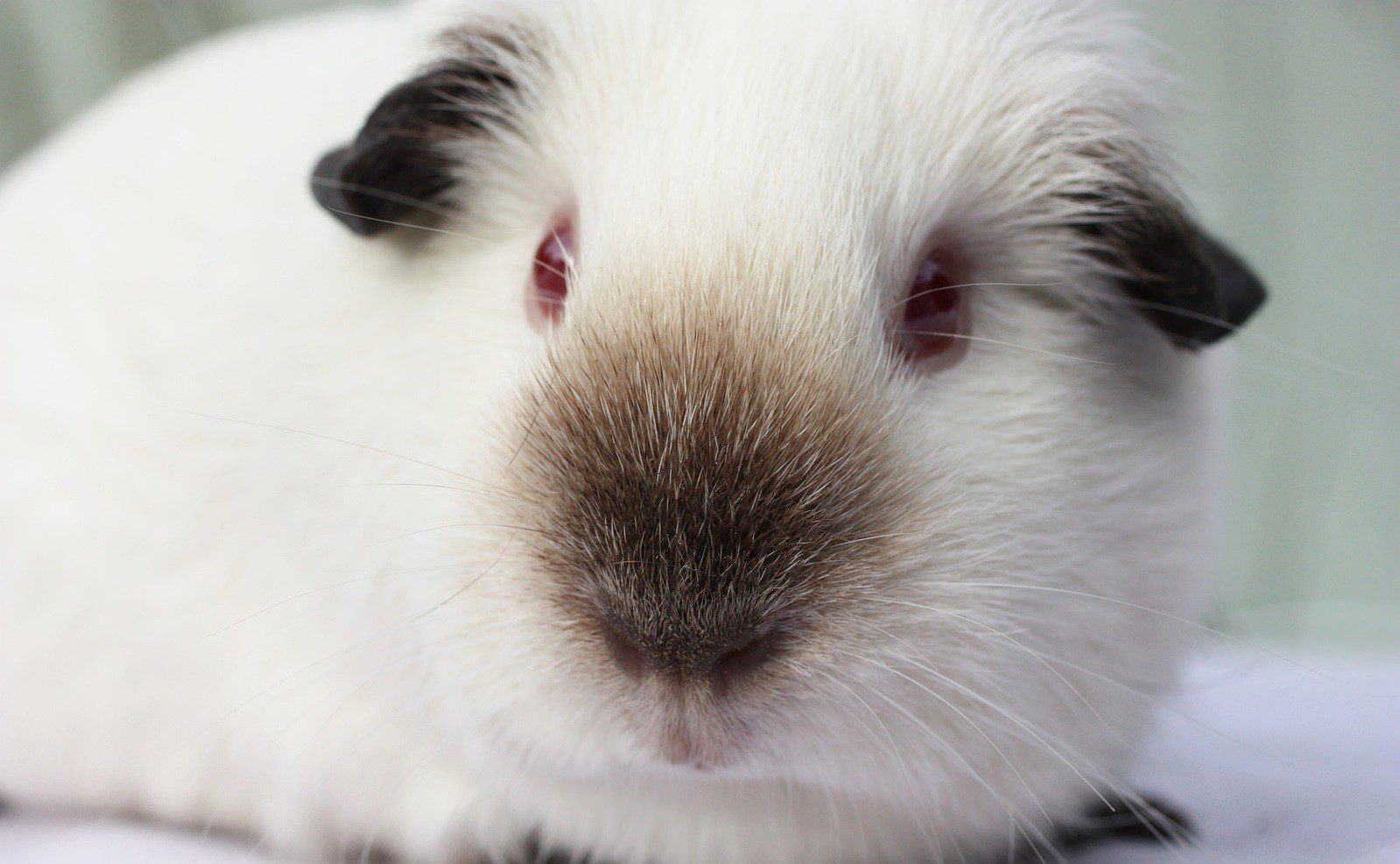
Himalayan pigs do not have pigment in their eyes, and therefore the eyes appear red, as we see blood vessels instead of pigment. The ideal mask on the muzzle of the Himalayan pig is pear-shaped, located strictly in the middle of the muzzle and sharply turning into white on the rest of the muzzle. In black gilts, the mask should be intensely black, while in brown Himalayans, the preferred color is light brown.
Himalayan pigs do not have pigment in their eyes, and therefore the eyes appear red, as we see blood vessels instead of pigment. The ideal mask on the muzzle of the Himalayan pig is pear-shaped, located strictly in the middle of the muzzle and sharply turning into white on the rest of the muzzle. In black gilts, the mask should be intensely black, while in brown Himalayans, the preferred color is light brown.
The wool of Himalayan pigs is white. The brighter the white color, the higher the animal is valued, although this parameter depends very much on the condition and age of the pig itself, as well as on the conditions in which it is kept.
Himalayan babies are born pure white, like albinos, and pigmented areas appear only with age and reach their full coloration by the age of six months. White color on the rest of the body is also largely dependent on the age of the gilt and on the conditions of detention, especially in brown Himalayans, and, with age, a strong contrast between body color and pigmented areas is more and more difficult to obtain. Although it cannot be said that well-colored adult pigs cannot be found.
The wool of Himalayan pigs is white. The brighter the white color, the higher the animal is valued, although this parameter depends very much on the condition and age of the pig itself, as well as on the conditions in which it is kept.
Himalayan babies are born pure white, like albinos, and pigmented areas appear only with age and reach their full coloration by the age of six months. White color on the rest of the body is also largely dependent on the age of the gilt and on the conditions of detention, especially in brown Himalayans, and, with age, a strong contrast between body color and pigmented areas is more and more difficult to obtain. Although it cannot be said that well-colored adult pigs cannot be found.
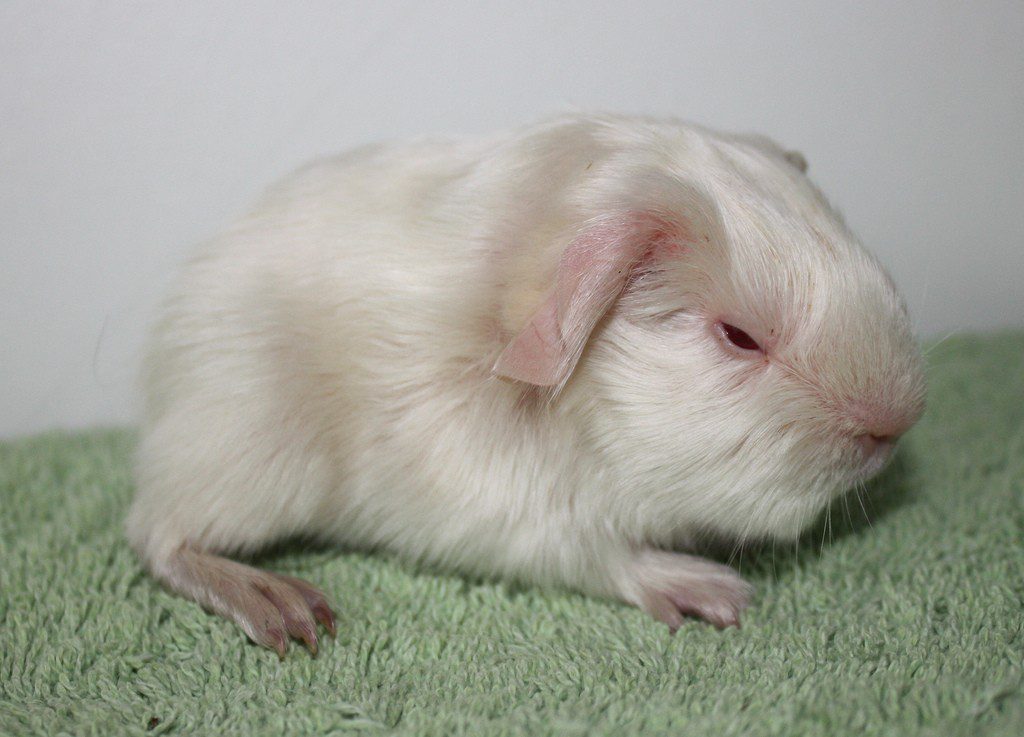
Provided that the pig is kept in a cool room (down to sub-zero temperatures), the pigment will naturally darken. The white color of the whole body also depends on this, although not only on this. In summer, dry and warm, the color on the pigmented areas of the body weakens, in contrast to the white color, which may not be affected. But it can change from the fact that the mumps is pregnant, or is in a stressful situation (at the exhibition or due to injuries and injuries).
Paws are a very important parameter in the appearance of the Himalayans. It must be remembered that in black Himalayans the pigment should be as black and intense as possible, and in browns it should be milky brown to the border of the knee tendon. The color in these areas is also highly dependent on many external factors and can change within a very small amount of time.
Provided that the pig is kept in a cool room (down to sub-zero temperatures), the pigment will naturally darken. The white color of the whole body also depends on this, although not only on this. In summer, dry and warm, the color on the pigmented areas of the body weakens, in contrast to the white color, which may not be affected. But it can change from the fact that the mumps is pregnant, or is in a stressful situation (at the exhibition or due to injuries and injuries).
Paws are a very important parameter in the appearance of the Himalayans. It must be remembered that in black Himalayans the pigment should be as black and intense as possible, and in browns it should be milky brown to the border of the knee tendon. The color in these areas is also highly dependent on many external factors and can change within a very small amount of time.
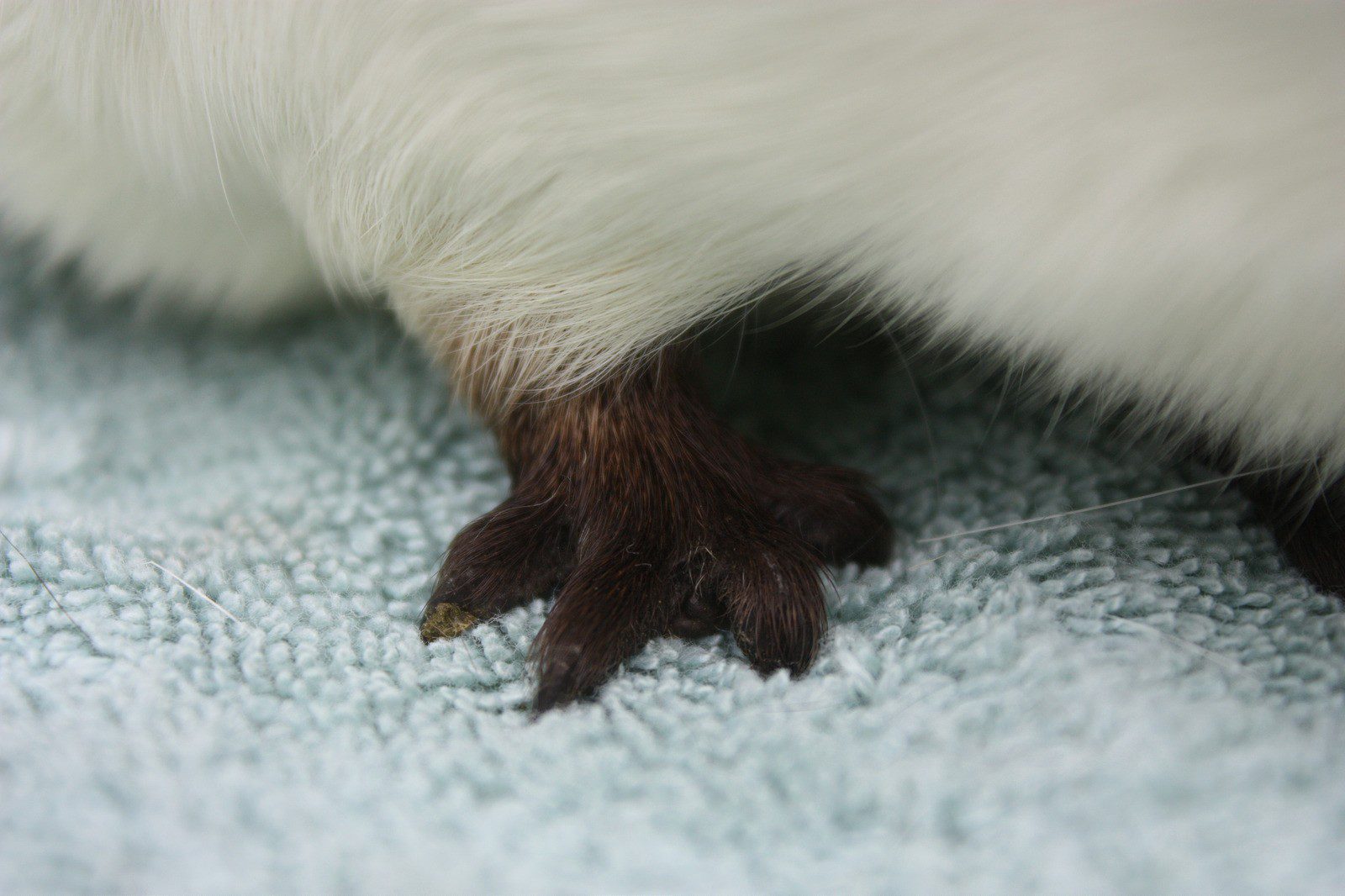
If a small Himalayan is born in the cold season, then his pigmentation will be very highly developed, while if the baby was born in the summer, then he will reach his peak form only six months later, when winter comes. Therefore, it is very, very difficult to acquire Himalayans from breeders. Preference should be given to adolescents under the age of six months. Newborns are born with pure pink paw pads that darken within a few days. While the pig is growing, on the paws and other parts of the body where there should be pigment, dark hairs, black or brown, slowly appear. In some lines, gilts reach full coloration at the age of 6-7 months, while in other lines, the formation of colored areas ends as early as 3-4 months.
If a small Himalayan is born in the cold season, then his pigmentation will be very highly developed, while if the baby was born in the summer, then he will reach his peak form only six months later, when winter comes. Therefore, it is very, very difficult to acquire Himalayans from breeders. Preference should be given to adolescents under the age of six months. Newborns are born with pure pink paw pads that darken within a few days. While the pig is growing, on the paws and other parts of the body where there should be pigment, dark hairs, black or brown, slowly appear. In some lines, gilts reach full coloration at the age of 6-7 months, while in other lines, the formation of colored areas ends as early as 3-4 months.
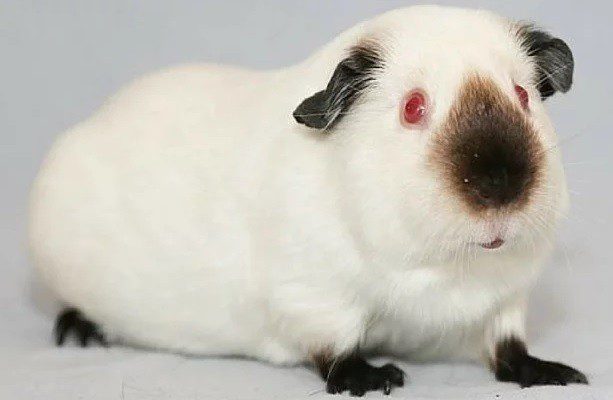
The ears of the Himalayans are large, in the shape of a rose petal, set wide apart and lowered down, without light borders along the edges. Small, not fully lowered ears do not look very attractive. Pigmentation all over to the base of the ears.
The eyes are bright pink, well set on a good broad muzzle.
A short, tightly knitted body with a broad head that resembles the shape of the head of a selfie.
The ears of the Himalayans are large, in the shape of a rose petal, set wide apart and lowered down, without light borders along the edges. Small, not fully lowered ears do not look very attractive. Pigmentation all over to the base of the ears.
The eyes are bright pink, well set on a good broad muzzle.
A short, tightly knitted body with a broad head that resembles the shape of the head of a selfie.
Explaining why Himalayan pigs darken in the cold
Himalayan guinea pig breeders have noticed this feature: when the ambient temperature drops to a certain level, Himalayan guinea pigs change color and darken.
Why does cold increase pigment levels in Himalayans? It should be noted that pigment levels will rise in cooler weather conditions and fall in warmer ones. This usually happens with some delay, as it takes some time for shedding and growing new hair. The change in coat color occurs not only in the colored areas (mask, paws, ears), but also on the entire white body.
If you pay attention to the white color of the body, you will notice that if there are areas of damaged hair on the body and new hair grows precisely in the cold period of time, the hair will grow darker in this area than on the rest of the body.
Usually Himalayans can have darker areas of hair along the spine, on the rump and sometimes on the shoulders in cold weather, i.e. where the cold penetrates the fur the most. Sometimes the coat can darken a little and become like a camouflage coloring, spotted. A purebred healthy Himalayan will always keep the white color of the coat, regardless of the degree of cold, which indicates that you have a real, thoroughbred specimen.
It should also be noted that temperature is not the only factor that affects the color, but the most noticeable. If you keep the Himalayan in a dark room and do not let them be in direct sunlight, the snow-whiteness of the coat will increase. Illness, injury or poor health can reduce the intensity of the pigment, for example, many people have experienced the problem of the disappearance of the mask or pigment on the paws after the fall of the pig or after the damage to the claw, i.e. those conditions associated with injury, bruising, or infection.
Himalayan guinea pig breeders have noticed this feature: when the ambient temperature drops to a certain level, Himalayan guinea pigs change color and darken.
Why does cold increase pigment levels in Himalayans? It should be noted that pigment levels will rise in cooler weather conditions and fall in warmer ones. This usually happens with some delay, as it takes some time for shedding and growing new hair. The change in coat color occurs not only in the colored areas (mask, paws, ears), but also on the entire white body.
If you pay attention to the white color of the body, you will notice that if there are areas of damaged hair on the body and new hair grows precisely in the cold period of time, the hair will grow darker in this area than on the rest of the body.
Usually Himalayans can have darker areas of hair along the spine, on the rump and sometimes on the shoulders in cold weather, i.e. where the cold penetrates the fur the most. Sometimes the coat can darken a little and become like a camouflage coloring, spotted. A purebred healthy Himalayan will always keep the white color of the coat, regardless of the degree of cold, which indicates that you have a real, thoroughbred specimen.
It should also be noted that temperature is not the only factor that affects the color, but the most noticeable. If you keep the Himalayan in a dark room and do not let them be in direct sunlight, the snow-whiteness of the coat will increase. Illness, injury or poor health can reduce the intensity of the pigment, for example, many people have experienced the problem of the disappearance of the mask or pigment on the paws after the fall of the pig or after the damage to the claw, i.e. those conditions associated with injury, bruising, or infection.
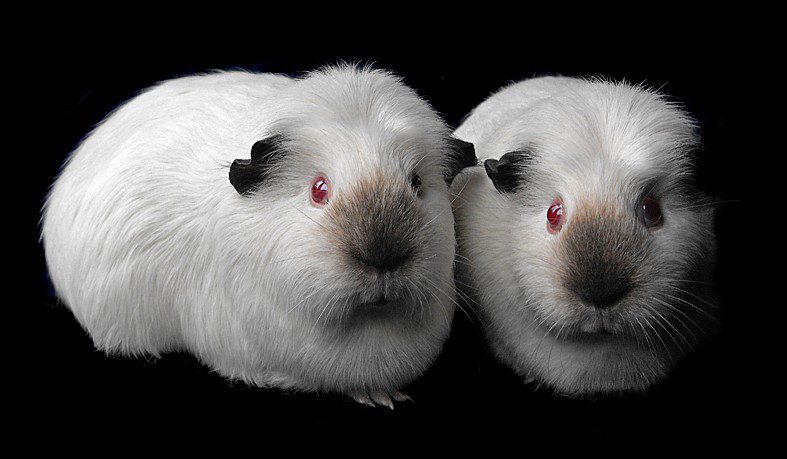
But let’s return to the question of why cold increases the level of melanin, and heat reduces its content in Himalayan guinea pigs. This breed has a double dose of the ChCh gene, which blocks certain enzymes (a chemical that exists in living organisms that causes other chemicals to change without changing itself), and these enzymes “hinder” the production of pigment on the body (with the exception of in certain areas). This is a biochemical reaction that has nothing to do with hormones. That is, under normal temperature conditions, we prevent the “obstructing” element from forming a pigment. At low temperatures (approximately -3 C), this biochemical process begins to fail and stops blocking the production of pigment.
This mechanism works exactly the opposite in summer, when the pigment is lost even in those parts of the body where it should be. Therefore, the first thing that needs to be done by those who breed Himalayan pigs is to find the optimal temperature conditions for animals. Breeders note that keeping gilts in cages closer to the floor improves the pigment. Conversely, those pigs that live on the upper floors of the racks have a weaker pigment.
In northern countries, such as Finland, Himalayans are not popular because it is very difficult to find the ideal temperature conditions for keeping them: in winter it is very cold outside and too warm indoors, since most of the premises are heated. There are also other factors. One is that the enzymes can interfere with pigment production in black gilts (black, chocolate, slate, etc.) and will completely block any pigment in red gilts (gold, cream, etc.). In this case, the red spot on the muzzle will look like white, because. the color cannot be expressed in any way, and an explanation of the fact why the red Himalayan variant cannot be derived.
But let’s return to the question of why cold increases the level of melanin, and heat reduces its content in Himalayan guinea pigs. This breed has a double dose of the ChCh gene, which blocks certain enzymes (a chemical that exists in living organisms that causes other chemicals to change without changing itself), and these enzymes “hinder” the production of pigment on the body (with the exception of in certain areas). This is a biochemical reaction that has nothing to do with hormones. That is, under normal temperature conditions, we prevent the “obstructing” element from forming a pigment. At low temperatures (approximately -3 C), this biochemical process begins to fail and stops blocking the production of pigment.
This mechanism works exactly the opposite in summer, when the pigment is lost even in those parts of the body where it should be. Therefore, the first thing that needs to be done by those who breed Himalayan pigs is to find the optimal temperature conditions for animals. Breeders note that keeping gilts in cages closer to the floor improves the pigment. Conversely, those pigs that live on the upper floors of the racks have a weaker pigment.
In northern countries, such as Finland, Himalayans are not popular because it is very difficult to find the ideal temperature conditions for keeping them: in winter it is very cold outside and too warm indoors, since most of the premises are heated. There are also other factors. One is that the enzymes can interfere with pigment production in black gilts (black, chocolate, slate, etc.) and will completely block any pigment in red gilts (gold, cream, etc.). In this case, the red spot on the muzzle will look like white, because. the color cannot be expressed in any way, and an explanation of the fact why the red Himalayan variant cannot be derived.
Photo of Himalayan guinea pigs
